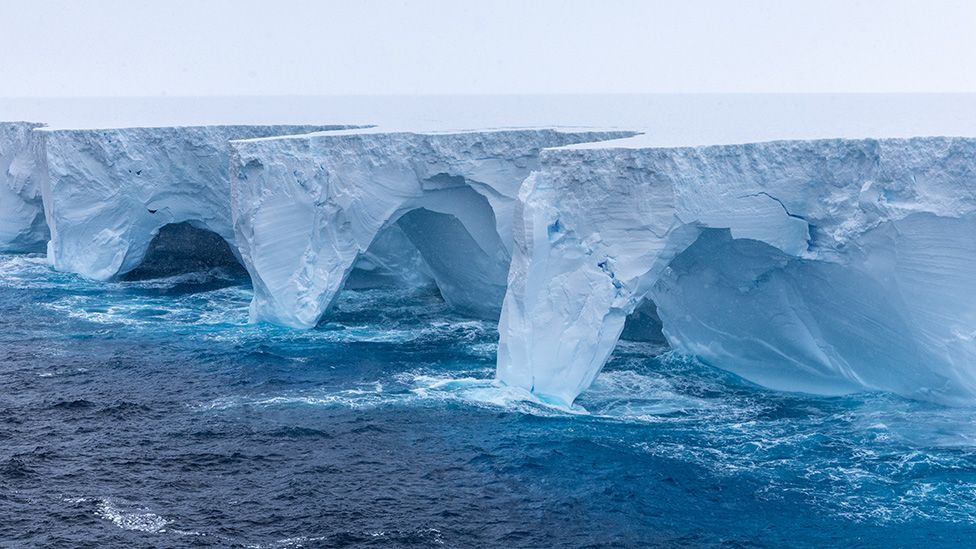ARTICLE AD BOX
 Image source, EYOS EXPEDITIONS/Richard Sidey
Image source, EYOS EXPEDITIONS/Richard Sidey
Wave action is cutting caves and arches in the walls of A23a
By Jonathan Amos
Science correspondent
Erosion is sculpting dramatic features into the world's biggest iceberg in what's likely to be the final months of its existence.
A ship run by the Eyos expeditions company arrived at the frozen behemoth, A23a, on Sunday to find huge caves and arches cut into its frozen walls.
The berg is being ground down by the warmer air and surface waters it's encountering as it drifts slowly away from the White Continent.
Ultimately, it will melt and disappear.
"We saw waves, a good 3m or 4m high, smashing into the berg," said expedition leader Ian Strachan.
"These were creating cascades of ice - a constant state of erosion," he told BBC News.
Image source, Copernicus Data/Esa/Sentinel-3
Image caption,Pictured from space: A23a is about 200km west of the South Orkneys, partially covered here by cloud
A23a broke away from the Antarctic coastline way back in 1986, but it's only recently begun a big migration.
For more than 30 years, it was stuck rigidly in the bottom-muds of the Weddell Sea, like a static "ice island" measuring some 4,000 sq km (1,500 sq miles) in area. That's more than twice the size of Greater London.
The colossus is presently entrained in the Antarctic Circumpolar Current, the great sweep of water that circles the continent in a clockwise direction.
This current, together with the prevailing westerlies, is pushing A23a in the general direction of the South Orkney Islands, which are about 600km (370 miles) northeast of the tip of the Antarctic Peninsula.
The berg has entered what scientists refer to as "iceberg alley", a track that passes South Georgia
It is firmly in the track of what scientists refer to as "iceberg alley" - the major route for the export of ice from the continent.
The interplay of winds, ocean fronts and eddies will determine its precise course over the coming weeks, but many of these giant flat-topped, or tabular, bergs end up passing by the British Overseas Territory of South Georgia.
Their destiny is to fragment and wither to nothing.
Image source, EYOS EXPEDITIONS/Richard Sidey
Image caption,A submerged terrace develops as the walls crumble. Buoyancy will force this terrace upwards
On Sunday, the Eyos team got close enough to A23a to put up a drone. The berg's 30m-high cliffs were topped by a dense mist. Icebergs on this scale create their own weather.
"It was dramatic and beautiful to photograph," said Eyos videographer Richard Sidey.
"It's mind-bogglingly big. I actually don't think we can fathom just how big it is; we can only know how big it is from science. It's certainly too big to photograph. It stretches as far as you can see in both directions."
Satellite observations can monitor its area coverage and gauge its thickness, which is over 300m (980ft) in places. In terms of mass, it's not far off a trillion tonnes, although this will be decreasing day by day.
Image source, EYOS EXPEDITIONS/Ian Strachan
Image caption,A dense mist hangs over A23a: It's so big it makes its own weather
The big question is: how long can A23a survive as it moves away from the colder climes of the Antarctic?
Milder air temperatures will create surface melt ponds that drain through the berg, helping to open up fractures. And those spectacular surface catacombs and arches will collapse to leave extensive areas of submerged ice that will then rise up under their own buoyancy to gnaw away at the berg's edges.
But another large block of ice ahead of A23a on the highway may be instructive in understanding its potential longevity.
Image source, Copernicus Data/Esa/Sentinel-3
Image caption,D28 is about 1,000 sq km (385 sq miles) in size and moving north of South Georgia
Iceberg D28, also known by its popular name "Molar Berg", is now moving up into the South Atlantic, some 200km (125 miles) north of South Georgia. Even though it's lost about a third of its area since calving from Antarctica's Amery Ice Shelf in 2019, D28 has managed to maintain its basic, compact shape.
Could A23a, with its own square-like dimensions, be similarly long-lived?

 1 year ago
20
1 year ago
20








 English (US) ·
English (US) ·